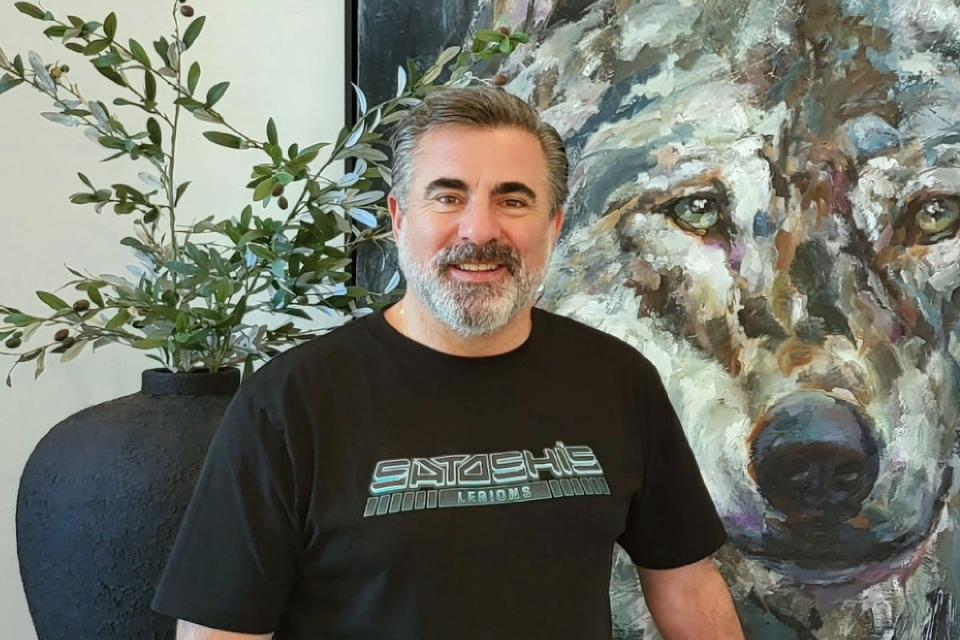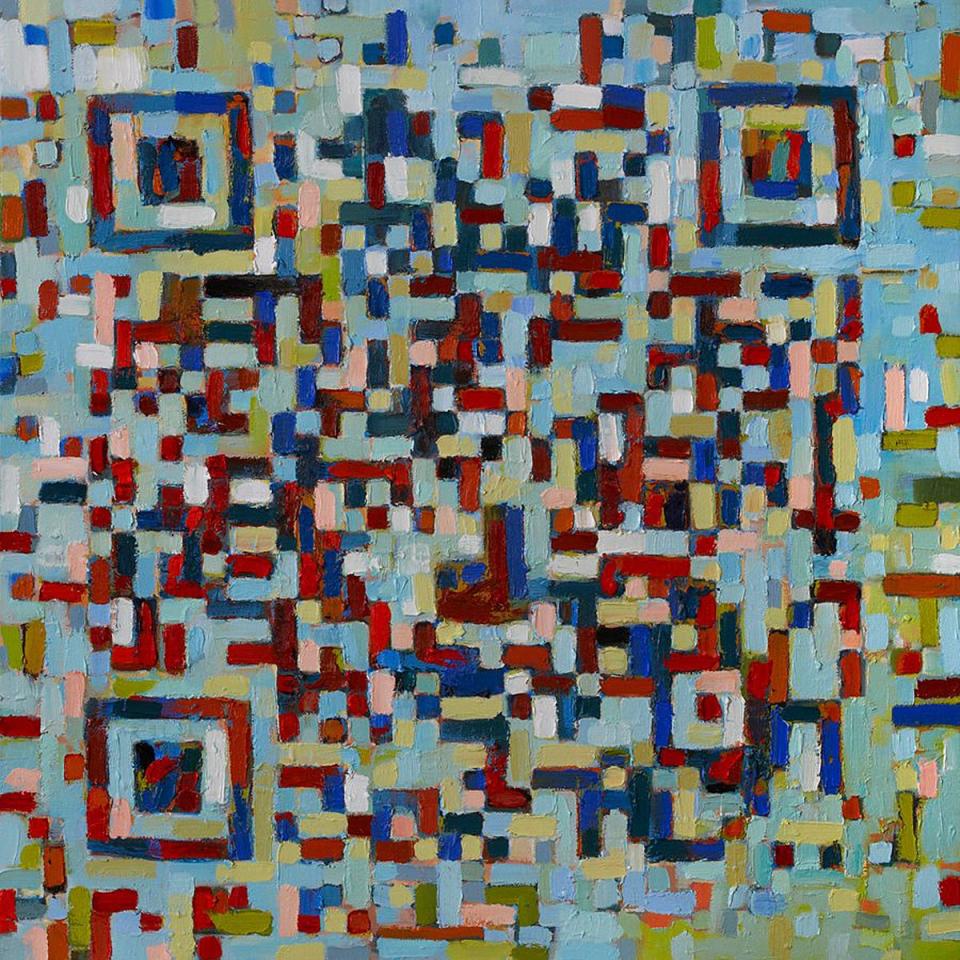How Trevor Jones became one of the world’s most successful NFT artists

After graduating from art school, Trevor Jones was “completely broke” and struggling to make ends meet – but the early adopter of NFTs, or non-fungible tokens, is now one of the most successful crypto artists in the world.
In 2021, the Edinburgh-based painter broke records when he sold an open edition NFT of his painting, The Bitcoin Angel, for the equivalent of £2.4 million. He has also teamed up with Succession’s Brian Cox, Scottish singer-songwriter KT Tunstall and crime writer Ian Rankin on a 2017 series of celebrity portraits entitled The Famous, and worked closely with American rapper Ice Cube over seven months for their collaborative mixed media work, 2021’s Man Vs. Machine.
And now the artist is linking up with the Evening Standard for an exclusive new NFT to mark the coronation of King Charles III. First created in his Edinburgh studio by Jones as a physical painting, The Oath captures the large jewels of St Edward’s Crown – also worn by the late Queen Elizabeth II during her coronation in 1953 – in vivid brushstrokes. Once transformed into an NFT in collaboration with Apollo Entertainment, the digitized final piece gives way to reveal a hidden, multi-layered world of animation, all inspired by the magnitude of the Coronation as a landmark moment in UK history.
Unlike many other NFTs, which are typically purchased with cryptocurrency, readers can own NFT The Oath with just an email address, opening this ever-growing area of the art world to an even wider audience.
“I’ve had a lot of great opportunities to work with some really amazing people,” says Jones, reflecting on his career. “Brian Cox was so funny,” but also too popular for his own good. “His cell phone was going off, literally every two minutes.” In many of the other augmented reality overlays from his interview video footage Jones has created to accompany his famous portraits, there is covert footage of his subjects discussing their lives. Cox, meanwhile, is now immortalized in digital time and space, constantly hanging on to people. “He’s just there taking phone calls: ‘I’ll be right back’. – No, no, I’m busy with something else. “I’ll talk in a moment.”

Describing himself as a “social realist painter”, Jones actually comes from a traditional art background, first creating his physical pieces by hand in a studio before later transforming them into interactive, shape-shifting digital pieces. He is now one of the leading names in the growing field of NFT artwork. No wonder he’s able to pack out an entire French villa for his annual Castle Party – a gathering for crypto-converts and token-curios, which raises money for the charity Maggie’s.
Trevor Jones’ life-changing journey into the art world began when he was 31, in the midst of what he characterizes as an “early mid-life crisis”. Originally raised in Lumby, a small logging community on the edge of Western Canada’s Monashee Mountains, following a creative path never felt like a tangible dream for Jones growing up.
Although he briefly moved to the big lights of Vancouver in his early 20s to pursue dreams of becoming a “rock star” – inspired by the likes of AC/DC, Iron Maiden and Metallica, playing what he now describes as ” terrible 80s rock” – Jones soon realized there was little money to be made and returned to his hometown. He got a job driving a loader at a gravel pit, but soon became restless and hit the road. After backpacking through Australia, he grandfather’s ancestry crossed over to Britain, eventually ending up in Edinburgh.
It was here that Jones decided to drastically start over and go to art school. Depression had taken him to “some very dark places” around that time, and art somehow felt like the answer. “Interestingly, art only gave me more questions and no answers, but it got me through the difficult years.”
By the time he graduated, he was in his late 30s, and “totally broke” with “nothing but a stupid art degree” to his name. “So it’s been quite an adventure since then…”
Art only gave me more questions, and no answers, but it got me through the difficult years
Trevor Jones
During his global travels, Jones was an early adopter of social media to stay connected, and has always been fascinated by technology. Fresh out of art school, with very little spare cash, he became interested in the largely untapped potential of QR codes—a unique, two-dimensional identifier that can be recognized by a smartphone—as a marketing method. So I started thinking on a creative level, what if I painted QR codes and created an embedded website? In a way, my paintings would become like a window, or a gate to a digital dimension.”
His 2016 collection Would I Lie to You: the Art of Politics and Propaganda meanwhile – which featured a number of world leaders including Justin Trudeau, Donald Trump and Vladimir Putin – paired his seemingly conventional art portraits with an added layer of AR, taking viewers to additional elements as a video, with an alternative narrative for each topic.
Jones thought he had struck gold with these earlier plays, but “unfortunately, no one cared,” at the time, he laughs. Yet the whole endeavor made him begin to question the processes and norms of the traditional art world, and he slowly began to distance himself as he struck out on his own. Then the stars aligned when Jones was first introduced to the idea of NFTs (non-fungible tokens), which are often bought and sold using cryptocurrency.
In essence, an NFT is a unique digital means of commerce, which is completely unique and cannot be replaced by anything else. While it’s certainly true that the leverage of owning a unique object is an ancient concept, what’s interesting about NFTs is specifically the way ownership data is stored in the form of digital “smart” contracts that travel with the object wherever it goes. In theory, it’s possible to turn practically anything you can think of into an NFT if there’s ownership involved – from music to house deals – but the technology is often used as a method to sell and trade digital art.
At first, he admits, he was confused by the whole thing—why on earth, he wondered, would anyone want to buy digital versions of physical art? It’s a very fair question, but the sheer interest in his earliest forays suggested the demand was there. When his first NFT piece EthGirl sold for a record 70 ETH (short for the cryptocurrency Ethereum), Jones knew he was on to something.

That play “opened my eyes to the possibility that this was real, and that there is an opportunity here to make a living,” he says.
So where does this value come from? For Jones, the answer lies in subverting the traditional structures and mechanisms of the art world. If someone turned up at Tate Modern and wanted to buy Matisse’s The Snail, they would probably be laughed right out of the Turbine Hall – conventionally, collecting art is often a fairly opaque process, involving having connections in the right places and being scrutinized as a buyer in advance.
This is not the case in the NFT world. Here, everything is available on the public record, with smart contracts also offering the option for an artist to continue earning royalties whenever their NFTs are resold in the future. For Jones, this means that he has continued to earn royalties on his best-known work, such as The Bitcoin Angel, since the first sale in 2021.
“It’s more democratic, and it’s also more transparent,” he says. “In the traditional art world, much of it takes place behind closed doors. I’m not saying it doesn’t happen in this space at the high end, but for the most part you can see exactly what was sold, and for how much.
Unlike delicate canvas, there’s also no need to worry about digital parts being damaged in transit.
Jones has long been interested in the idea of modern-day icons in his work, immortalizing world figures alongside divisive personalities such as Dr Jordan Peterson and Milo Yiannopoulos.

As he prepares to publish a brand new NFT work to mark the coronation of King Charles III, in collaboration with this newspaper, the same idea of iconography plays naturally in his mind. It’s hard to name a more ubiquitous establishment, after all, than the British royal family – their name emblazoned across every letterbox, every note, in Britain.
“As a painter, and from studying art history, I recognize the value of the social content that artists have contributed over the centuries,” he says. Creating a new piece reflecting the coronation of the king, he continues, feels like a once-in-a-lifetime chance to commemorate a truly historic day. “I try to capture the things happening in the world today that are relevant, and our unique monumental occasions. This happens to be one of them”
“What are the odds, you know? A lad from Lumby, living in the UK now as an artist, and able to create this amazing piece of art in collaboration with the Evening Standard.”
To mark the coronation of King Charles III on 6 May, the Evening Standard has teamed up with Trevor Jones for a brand new piece of commemorative artwork, available as an exclusive free NFT to Evening Standard readers. It will be available between May 4 and 7 Nice gateway
The Bitcoin Angel Castle Party is at Château de Vallery near Paris from September 3 to 5; for ticketed visits trevorjonesart.com


